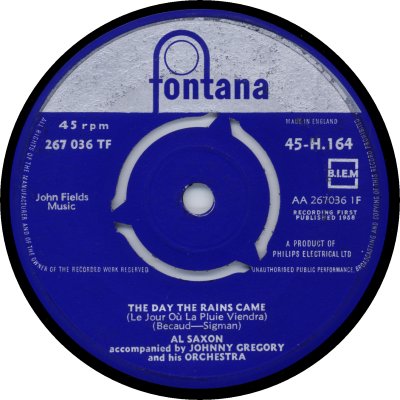
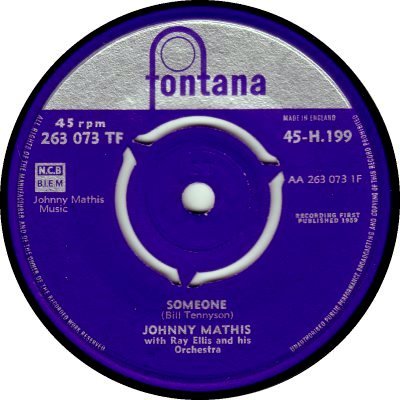
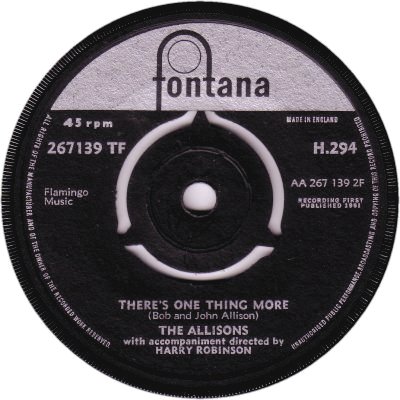
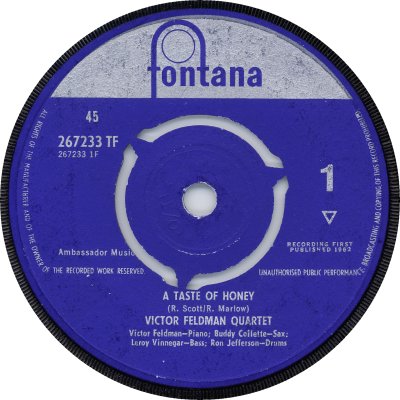

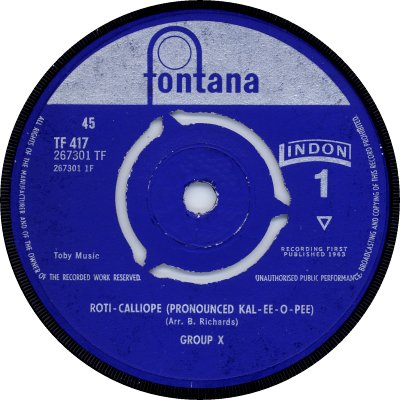
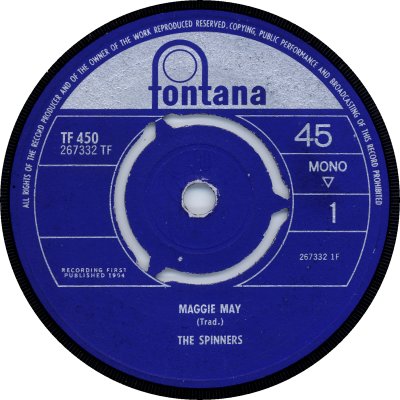
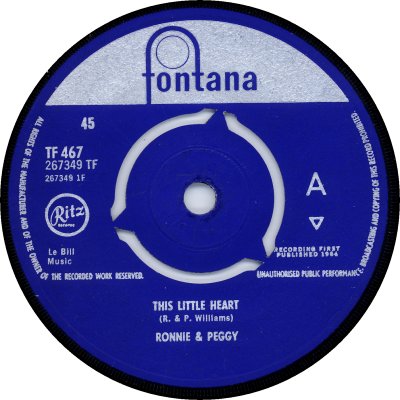
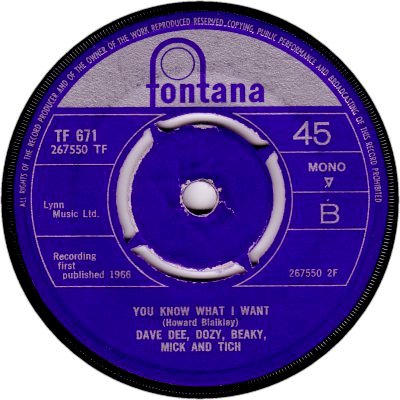
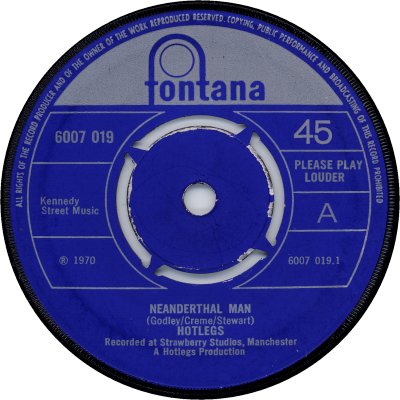
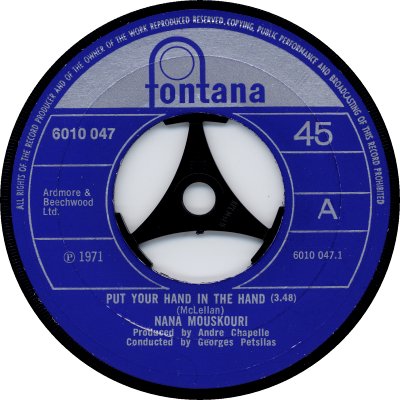
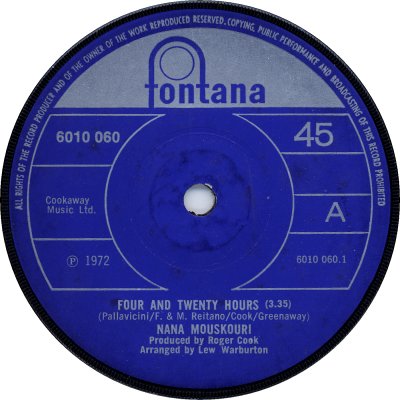

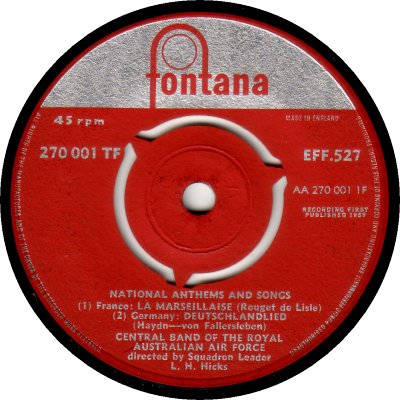
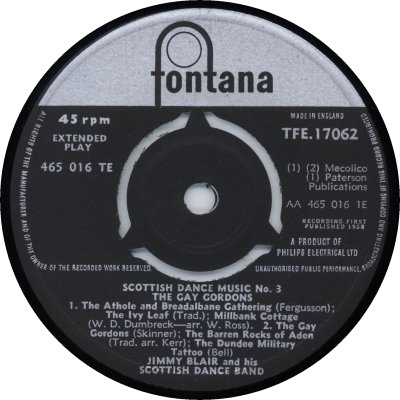
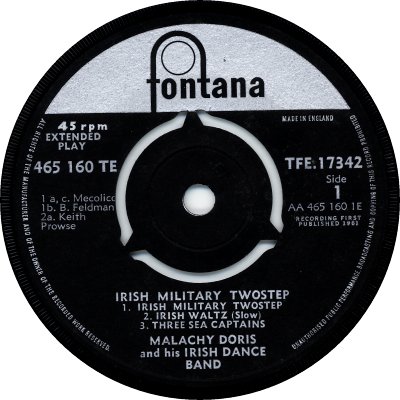
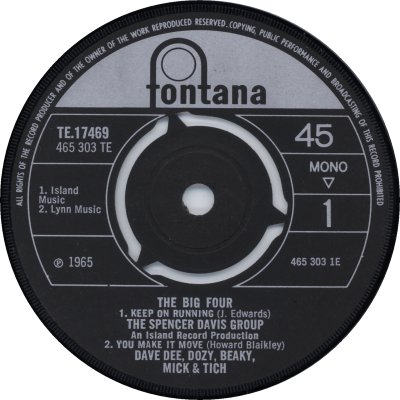
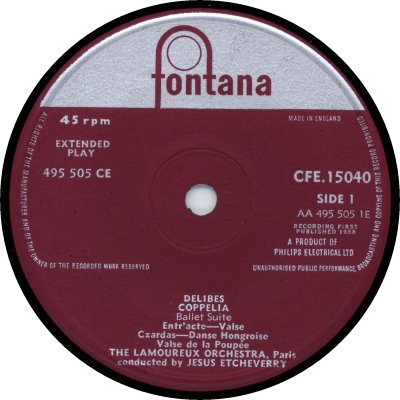
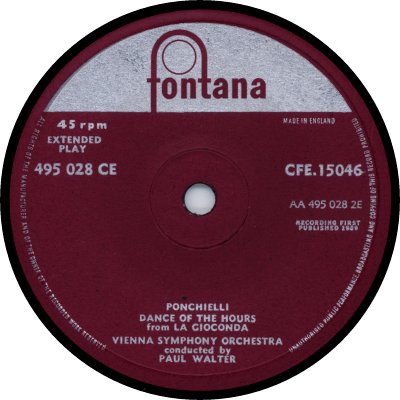
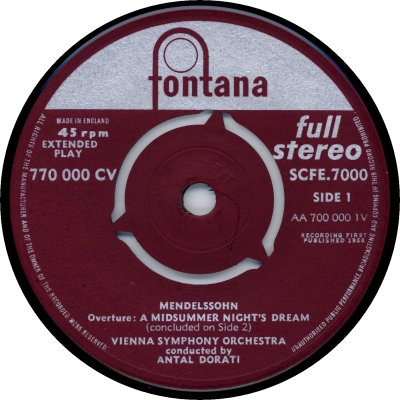
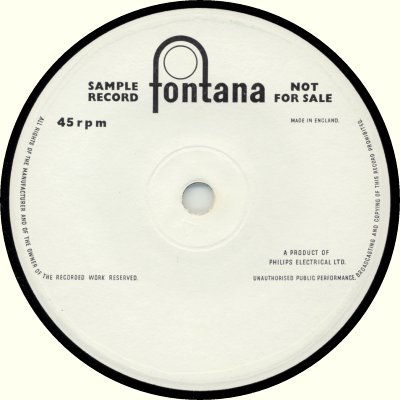
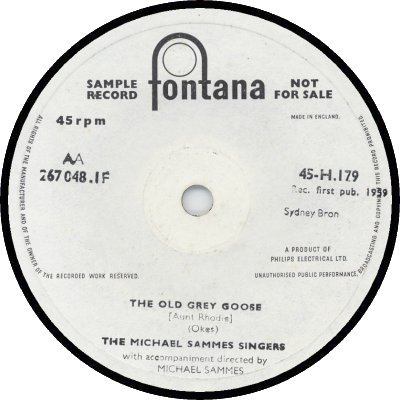
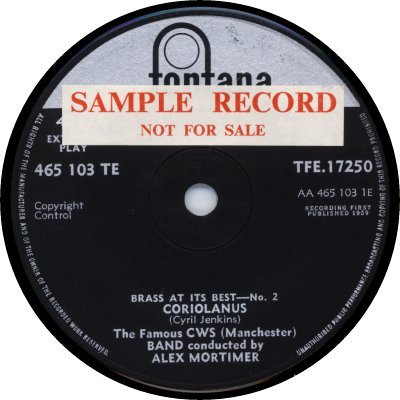
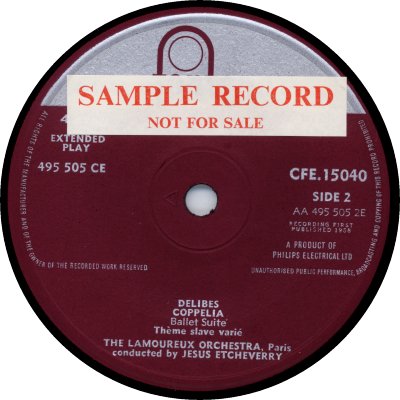
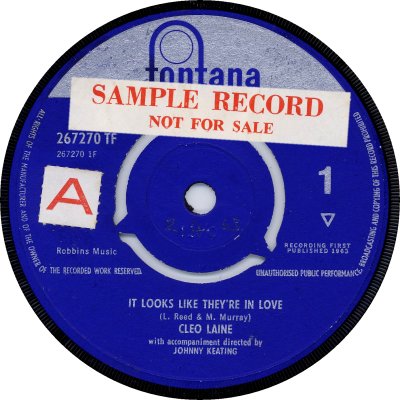
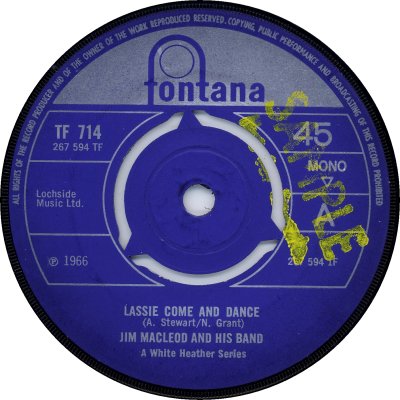
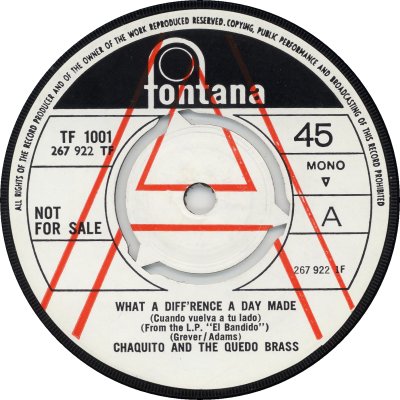
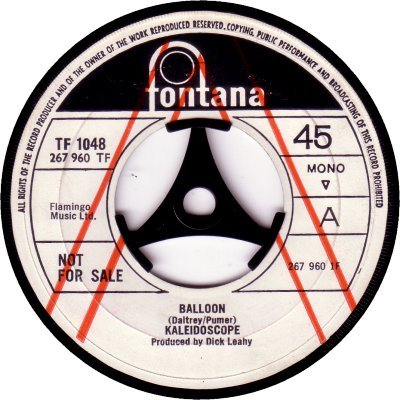
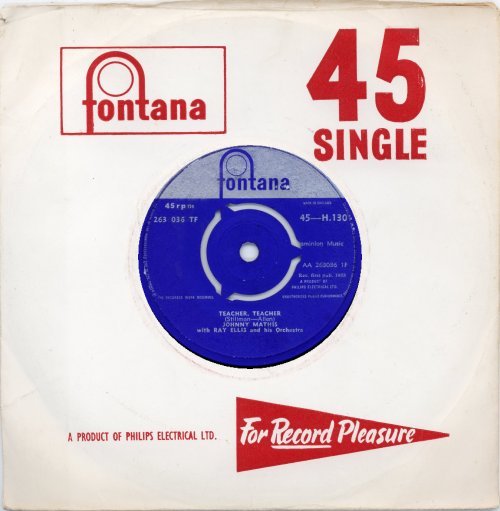
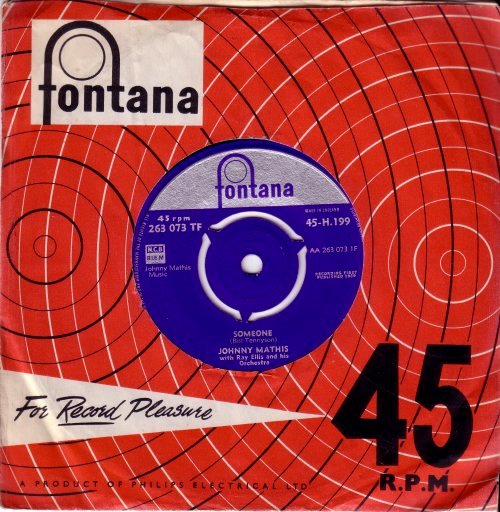
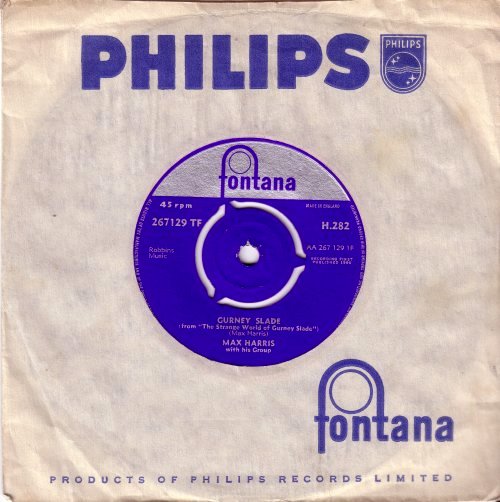
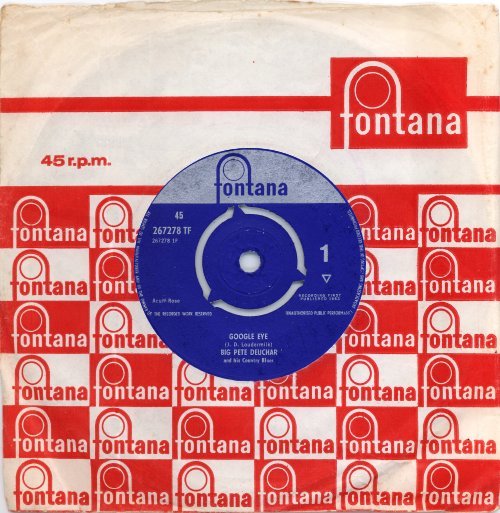
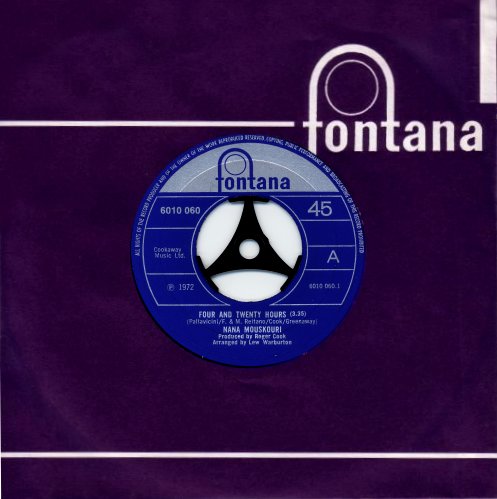
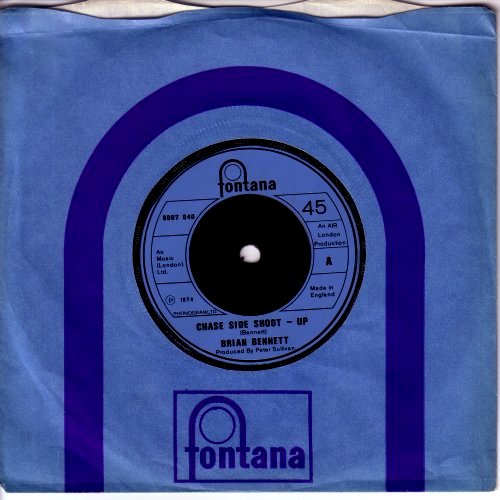
A subsidiary of Philips (later Phonogram), Fontana first saw the light of day in January 1958. Its advent was forecast in 'Billboard' of the 16th of December 1957, which said that it was to be used primarily as an overspill label for artists from the Columbia and Epic labels of the American 'Columbia' company, which was to be supplying Philips with much of its material initially. Among those artists was Johnny Mathis, who according to the article was going to be first in line for a promotional push. The push seems to have worked, as Mathis provided Fontana with nine hit singles over the next three years. The biggest of them was the second, 'A Certain Smile' b/w 'Let It Rain' (H-142; 8/58), which climbed as high as No.6, but a couple of the others broke into the Top 10. In addition to the American artists there were some home-grown ones, one of whom, Al Saxon, gave Fontana a trio of smaller hits during that period. The man in charge of the label was A&R chief and later label manager Jack Baverstock, who was to stay with it for eleven years and who turned it into a hit machine for a good part of that time.
For the first four years of its life Fontana put out far more EPs than singles: over the two-year period 1958-59 the figure was around 200 Popular EPs and approximately 50 Classical ones against some 130 Pop singles. It was not until 1962 that singles began to predominate. After that time the EP format gradually dwindled away, the last EP coming out in December 1967. To return to the subject of singles, Fontana's blend of material from American Columbia and its own productions gave it a decent showing in 1961. Cleo Laine and Tony Orlando both had No.5 records; The Dave Brubeck Quartet scored twice, 'Take Five' b/w 'Blue Rondo A La Turk' (H-339; 10/61) only just failing to get that high; and Buzz Clifford provided a Top 20 entry in the shape of the novelty 'Baby Sittin' Boogie' b/w 'Driftwood' (H-297; 2/61). The Allisons bettered them all, however, 'Are You Sure' b/w 'There's One Thing More' (H-294; 2/61) just missing out on the No.1 position. 1962 was less impressive, with only three Chart entries, by Brad Newman, The Allisons and Patti Lynn, none of which rose above the No.30 position.
The comparative lack of hits in 1962 was in part due to Fontana losing its main source of recordings, which it did in May 1962 when Philips gave Columbia a label of its own, 'CBS'. Oddly, material on Epic and its associated Okeh label didn't move to CBS - having separate distribution to Columbia in the States the two appear to have been viewed as semi-detached. Instead EMI moved in to secure them, and for several years their recordings came out on the UK Columbia label ('BB', 21st April 1962). 'BB' of the 27th of January said that in anticipation of Columbia material no longer being available to bulk out the Philips and Fontana catalogue Philips was expected to expand its activities; a start had been made with the licensing of another American label, Vanguard. Vanguard was more of an album label than a singles one, but 'Walk Right In' b/w 'Cool Water' by The Rooftop Singers (TF-271700; 1/63) hit the No.10 spot fairly early on, and Joan Baez enjoyed five Chart successes during 1965-66, only one of which, 'There But For Fortune' b/w 'Plaisir D'Amour' (TF-587; 6/65), managed to outdo the Rooftoppers - it reached No.8. 'Billboard' of the 14th of February 1962 observed that Philips appeared to be developing Fontana as its prime outlet for tracks licensed from independent American productions, and pointed out that the label had gained the rights to three Tamla singles, by The Miracles ('What's So Good About Goodbye' b/w 'I've Been Good To You'; H-384, 3/62), The Marvelettes ('Twistin' Postman' b/w 'I Want A Guy'; H-386, 3/62) and Eddie Holland ('Jamie' b/w 'Take A Chance On Me'; H-387, 3/62). Fontana's interests weren't restricted to singles and the Hit Parade: 'BB' of the 28th of April 1962 commented that the label was responsible for much of the current recording of Modern Jazz in the UK.
1963 was only a slight improvement on 1962 as far as hit singles were concerned, but in addition to the Rooftop Singers record mentioned above and a novelty seasonal No.20 by Dora Bryan, 'All I Want For Christmas Is A Beatle' b/w 'If I Were A Fairy' (TF-427; 11/63), it sowed the seeds of future success in the form of a modestly placed No.46 spot for the first single by Wayne Fontana & The Mindbenders, 'Hello! Josephine' b/w 'Road Runner' (TF-404; 6/63). The Merseybeats were the obvious success of the year, with two Top 30 records; 'I Think Of You' b/w 'Mister Moonlight' (TF-431; 12/63) did the better of the two, just making the Top 5. 1964 was a definite improvement. Millie, Wayne Fontana & The Mindbenders, The Merseybeats and The Pretty Things all scored more than once, with Millie's 'My Boy Lollipop' b/w 'Something's Gotta Be Done' (TF-449; 2/64) giving Fontana its second No.2 and 'Um, Um, Um, Um, Um, Um' b/w 'First Taste Of Love' (TF-497; 9/64) by Wayne Fontana and his men reaching No.5. In that same year Philips linked up with Tito Burns's independent production company Lindon to form Fontana-Lindon Records ('BB', 4th May 1963). The first fruit of the deal was Eden Kane's final hit, 'Boys Cry' b/w 'Don't Come Crying To Me' (TF-438; 1/64), which climbed to No.8. His earlier hits had been placed with Decca. A similar deal was done with another independent production company, Bunny Lewis's 'Ritz Records', the following year. In both cases the link was shown by the addition of the minor company's logo to the Fontana label. One single that went more or less unnoticed was 'Zoot Suit' b/w 'I'm The Face' by a group called The High Numbers (TF-480; 7/64). The group moved to Brunswick Records and changed their name to The Who; 'The rest is history', as they say. Copies of 'Zoot Suit' now sell for four-figure sums.
Fontana really got into its stride in 1965. After three minor hits which failed to break into the Top 40 The Spencer Davis Group finally took the label to the top of the Charts, with 'Keep On Running' b/w 'High Time Baby' (TF-632; 11/65). Wayne Fontana & The Mindbenders got to the No.2 position with 'The Game Of Love' b/w 'Since You've Been Gone' (FT-535; 1/65), and after two lesser successes and a split The Mindbenders repeated the trick on their own with 'A Groovy Kind Of Love' b/w 'Love Is Good' (TF-644; 12/65). Wayne Fontana's first solo release, 'It Was Easier To Hurt Her' b/w 'You Made Me What I Am Today' (FT-642; 11/65) was less successful, stalling outside the Top 40. In addition The Pretty Things and The Merseybeats both added to their tally of hits, Betty Everett and The Silkie added one-off Top 30 entries, and Joan Baez chipped in with the first four of her five Chart entries for the label. More significantly, after two misses a band with the somewhat long-winded name of Dave Dee, Dozy, Beaky, Mick & Tich achieved their first hit, 'You Make It Move' b/w 'I Can't Stop' (TF-630; 11/65) reaching the No.26 spot.
1966 was Fontana's golden year, with twenty-six singles making it into the Charts. The Spencer Davis Group followed up one No.1 with a second, 'Somebody Help Me' b/w 'Stevie's Blues' (TF-679; 3/66), and nearly achieved the feat again later in the year, 'Gimme Some Loving' b/w 'Blues In F' (TF-762; 10/66) falling one place short. In between there came another No.1, this time by The Troggs. After just missing the top spot with 'Wild Thing' b/w 'From Home' (TF-689; 4/66) they went one better with 'With A Girl Like You' b/w 'I Want You' (TF-717; 7/66), after which they moved on to their manager Larry Page's 'Page One' records. Dave Dee and his lads had four Top 10 singles, 'Hold Tight' b/w 'You Know What I Want' (TF-671; 2/66) and 'Save Me' b/w 'Shame' (TF-775; 12/66) both climbing to No.4, and 'Bend It' b/w 'She's So Good' (TF-746; 9/66) going two places higher. Other Top 10 positions were provided by Bob Lind, The Merseys, The New Vaudeville Band, and Manfred Mann (twice), with The Merseybeats, Wayne Fontana, The Pretty Things, The Merseys, The Mindbenders, Joan Baez, Bob Lind and Peter Fenton adding lesser hits.
Perhaps inevitably the number of Chart entries dropped in 1967, but there were still thirteen of them, a very respectable tally. Dave Dee and the gang managed another two Top 5 singles as well as a relatively disappointing 13th spot, 'Zabadak!' b/w 'The Sun Goes Down' doing best with a No.3 position. The Spencer Davis Group added two more hits before leaving for United Artists, and The New Vaudeville Band did well to capitalize on their novelty 1966 hit 'Winchester Cathedral' b/w 'Wait For Me Baby' (TF-741; 8/66) with two well-placed follow-ups before tailing off and moving to Decca. One successful arrival was The Herd, who came over from Parlophone and missed with their first Fontana single before getting to No.6 with 'From The Underworld' b/w 'Sweet William' (TF-856; 8/67). Manfred Mann's 'Ha Ha Said The Clown' b/w 'Feeling So Good' (TF-812; 3/67) got as high as No.4, but its instrumental follow-up, 'Sweet Pea' b/w 'One Way' (TF-828; 5/67), proved a bit of a let-down and only just struggled into the Top 40. In addition The Merseys added their final hit - a minor one - in the shape of 'The Letter' b/w 'My New Day And Age' (TF-869; 9/67).
The number of hits and hit-makers fell sharply in 1968, though placings remained high. The year started with a bang, or more accurately two bangs: both Manfred Mann and Dave Dee, Dozy, Beaky, Mick & Tich got to the top of the Charts, the former with 'The Mighty Quinn' b/w 'By Request - Edwin Garvey' (TF-897; 1/68), the latter with 'The Legend Of Xanadu' b/w 'Please' (TF-903; 2/68). Both groups added a couple more hits in very respectable placings. Other than those, the sole contribution came from The Herd, whose 'I Don't Want Our Loving To Die' b/w 'Our Fairy Tale' (TF-925; 3/68) reached No.5. One single which bombed was 'Slow Motion' b/w 'It's Lonely Out There' (TF-958; 7/68) by a band that was to be huge in the '70s - The Sweet. It was their only single for Fontana.
In retrospect there was something of an 'End of an era' air to 1969. The big event of the year was the departure of Jack Baverstock, who had been the driving force behind Fontana since its formation ('Record Retailer', 30th August). On the artist front, Dave Dee and the band added a couple of lesser hits to their catalogue before Dee departed, and Manfred Mann chalked up another before being shifted across to Philips's 'progressive' label, Vertigo. American group Steam proved a one-off Top 10 hit with 'Na Na Hey Hey Kiss Him Goodbye' b/w 'It's The Magic In You Girl' (TF-1058; 9/69), while Fontana's biggest hit came from Jane Birkin and Serge Gainsbourg, whose controversial 'Je T'Aime... Moi Non Plus' b/w 'Jane B' (TF-1042; 6/69) reached the No.2 position before Philips bowed to public pressure and withdrew it on moral grounds. It was picked up by Major Minor and went to No.1. Elsewhere, another band with a big future passed through the ranks of Fontana's artists: Ambrose Slade's 'Genesis' b/w 'Roach Daddy' (TF-1015; 5.69) was followed by shortenings of the band's name, firstly to The Slade for 'Wild Winds Are Blowing' b/w 'One Way Hotel' (TF-1056; 10/69) and finally to Slade for 'Shape Of Things To Come' b/w 'C'Mon, C'Mon' (TF-1079; 3/70). As Slade they moved to Polydor, and, after a fourth unsuccessful single, set off on the run that was to make them one of the best-selling bands of the Glam years.
After Baverstock left, much of the impetus behind the Fontana label seems to have died out. In 1970 there were only three hits, and two of those came from established Fontana artists. Under the snappier name of 'D, B, M & T' Dozy, Beaky, Mick & Tich registered their only Dave-Dee-free Chart record, 'Mr. President' b/w 'Frisco Annie' (6007-022; 6/70), but it got no higher than No.33. Dave Dee's first solo single, 'My Woman's Man' b/w 'Gotta Make You Part Of Me' (TF-1074; 1-70), made it into the Top 50 but failed to break into the Top 40. Far and away the highest placing of the year was a No.2 from Hotlegs, with their novelty 'Neanderthal Man' b/w 'You Didn't Like It, Because You Didn't Think Of It' (6007-019; 6/70). One single that didn't make the Charts was the first from a new band called Black Sabbath. 'Evil Woman' b/w 'Wicked World' (TF-1067; 1/70) came out in Fontana in January but reappeared a couple of months later as the second single on Vertigo, where both it and the band looked more at home. The end was in sight for Fontana. Its final single as a fully-functioning label came in January 1971, the honour going to a reissue of Alan Haven's 'Image' b/w 'Romance On The North Sea' (TF-267 428). After that, only an occasional single by Nana Mouskouri kept the Fontana name alive over the course of the next three years - there was one apiece in 1971, 1972 and 1973. Artists who had previously been on Fontana and who were still on Philips's roster were shifted across to the Philips label.
All was not lost, however. Philips made a couple of attempts at reviving the label. The first came in March 1974 and involved the release of a dozen singles including another from Nana Mouskouri, but chart success was not forthcoming and Fontana found itself back in hibernation by the time autumn rolled around. The second attempt featured five New Wave and Reggae singles, which appeared in 1980-81 and met with an equal lack of success. Happily a better and far more prolonged new lease of life came in 1987 when Fontana was handed over to Phonogram A&R man David Bates. With signings such as Was (Not Was), Pere Ubu, The Lilac Time, The House of Love, Swing Out Sister, Tears For Fears and James, Bates gave the old brand a contemporary new flavour and introduced it to a new generation of music buyers. As a result, through the '80s and beyond, it featured frequently in the Charts once again.
The design of the Fontana label changed only fractionally over the course of its existence. Singles' labels were usually coloured blue with silver printing, though the occasional silver-on-black one (3) can be found. At first the prohibitions around the circumference of the label were diverted slightly at the bottom, giving a vaguely moustachioed effect (1); they took up a more normal position in or around May 1959 (2) only to go back to their old place in September 1961 (4, 5). As mentioned above, the arrangements with the Lindon and Ritz production companies led to their logos featuring on the labels (6, 8). A grid of lines appeared on the label from February 1964 onwards, and the prohibitions moved again (7). After the first handful of gridded singles the '1' and '2' denoting the appropriate sides were replaced by 'A' and 'B' (9). As was usual for Philips-group records there were usually three dinking perforations, though singles with four perforations (10) exist - these were contract pressings, done by other firms. Again following the Philips custom, many singles had their centres cut out in the factory and were sent out with three-pronged 'spiders' (11). Undinked copies of some singles exist (12) but they are unusual. The injection moulded labels (13) date from the 1974 revival, as does the pale-blue company sleeve (34). A 'Cameos' series of well-known Classical / Light Orchestral singles had red labels (14). EP labels had the same designs as those of singles but were coloured differently: the Popular series was black (15, 16, 17), the Classical one purple (18, 19, 20). Stereo EPs were marked appropriately (20).
Initially promotional records had white labels which could be blank (21) or could have the details written or printed on them (22). 'Sample Record' stickers came into use in 1959 (23, 24) and had replaced the white labels entirely by the Autumn of 1960. Around February 1962 an 'A' sticker was added to the 'Sample' ones (25); then early in 1966 the stickers were replaced by rough-looking yellow hand-stamped markings (26). The white label made a comeback at the start of 1969, with an altered design and a large hollow red 'A' (27, 28). With regard to company sleeves, the white one (29) was short-lived, serving for only the first six months or so of Fontana's existence, after which the red one (30) took over and saw out the decade, possibly lasting into 1961. By 1962 a dual Philips / Fontana sleeve (31) was being used by both labels. When separate sleeves were adopted again, at the start of 1963, Fontana received a red 'boxed' one (32). The following year - in the summer? - the boxed design was dropped and a dark-blue coloured sleeve (33) made its debut. It served throughout the glory years and on until Fontana was shelved, and is the one with which the record-buying public was most familiar. As mentioned above, singles from the 1974 revival were given sleeves in a new two-shades-of-blue design (34).
At the time of the label's launch Fontana 7" singles were numbered in the 45-H-100s, the '45' distinguishing them from the 10" 78rpm discs, which had plain H-100 numbers. A six-figure number with a 'TE' suffix appeared on the left of the label in an almost equally large font - this was used by Philips worldwide, and was basically the same as the matrix number. The 45-H-100s lost the '45' in April 1960 after Philips abandoned the 78rpm format, H-249 being the first 7" to be affected. They evolved into the H-390s by April 1962, at which point they were dropped, the six-figure numbers becoming the catalogue numbers (4). The main series was 267200-TF, but there were others such as 261300-TF and 270100-TF, which presumably came from different sources. In April 1963 numbering went back to the old three-figure scheme, starting off where it had stopped, in the '390's, but the 'TF' was retained, this time as a prefix. Whereas the 'H' numbers had been on the right-hand side of the label the 'TF's were on the left; the six-figure numbers were now underneath them, and were smaller than them (5). The TF-000s grew into TF-1000s in due course. In 1970 Philips began numbering the singles on all their labels with seven-figure 6000-000 numbers. The majority of Fontana's old TF numbers were replaced by a 6007-000 series, though there were a few 6001-000s; singles originating in France used a different series, 6010-000. Singles from the 1974 revival continued to use the 6007-000 numbers, starting at 6007-030. Two singles by Weapon Of Peace in the early '80s revival went back to the TF-1000 numbering, starting at TF-1082 where the old series had left off. The red-labelled Classical singles had their own EFF-500 numbers. The main series of Popular EPs had TFE-17000 catalogue numbers, which were dropped along with the H-100s during the 1962-63 period, the six-figure 465200-TEs (and some others such as 467200-TE) taking their place temporarily. When they returned they lost an 'F' and became TE-17000s. EPs of material originating with Vanguard were given a TFE-18000 series to themselves, while EPs of Classical music had their own CEF-15000 numbers. Stereo Popular EPs had a separate STFE-8000 series, stereo Classical EPs an SCFE-7000 one. The discography below deals only with the 1970s.



Copyright 2006 Robert Lyons.

